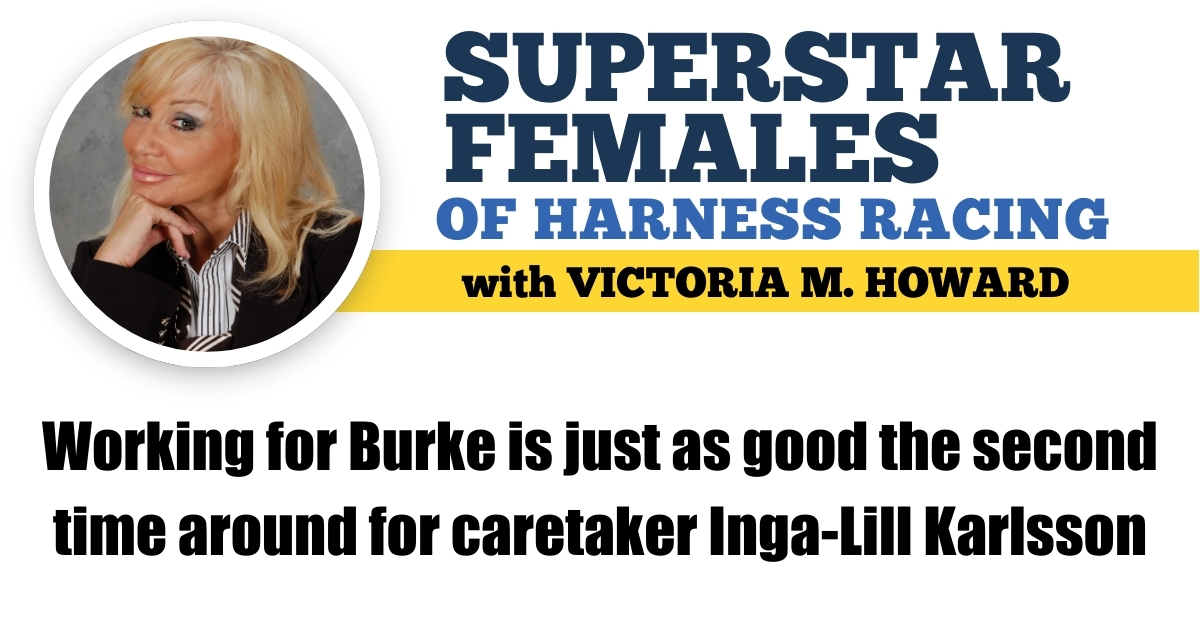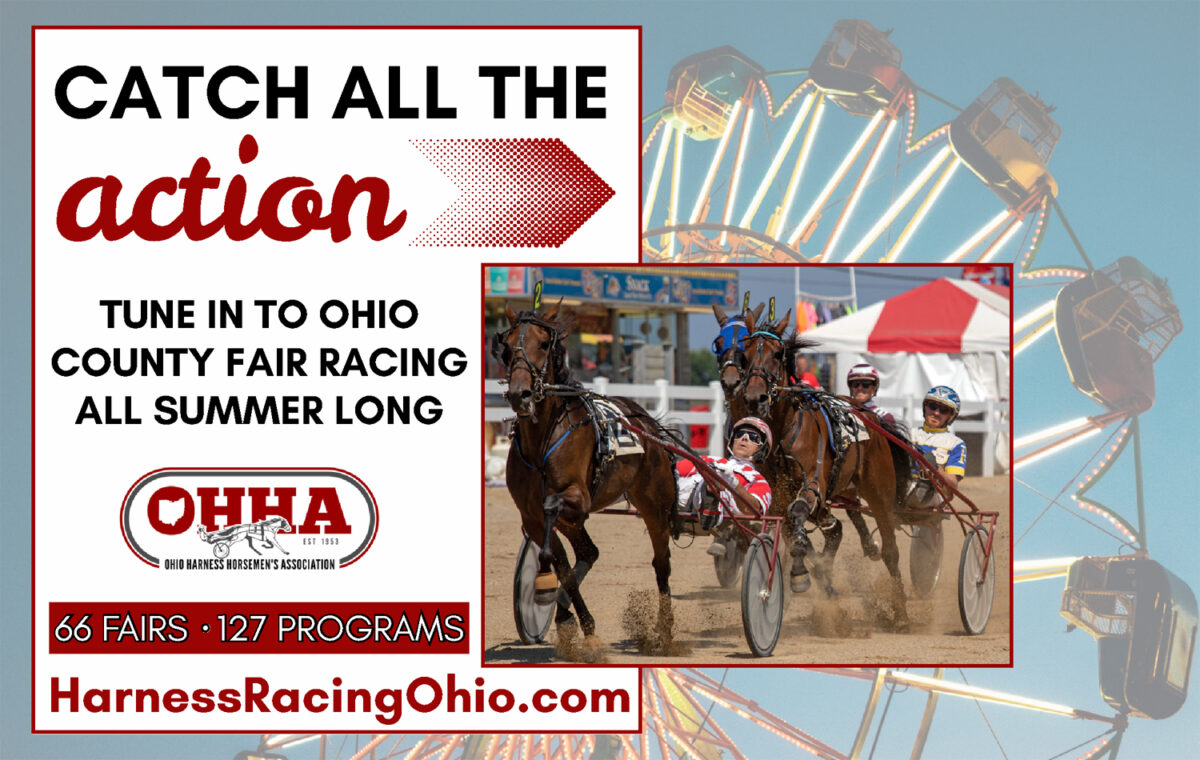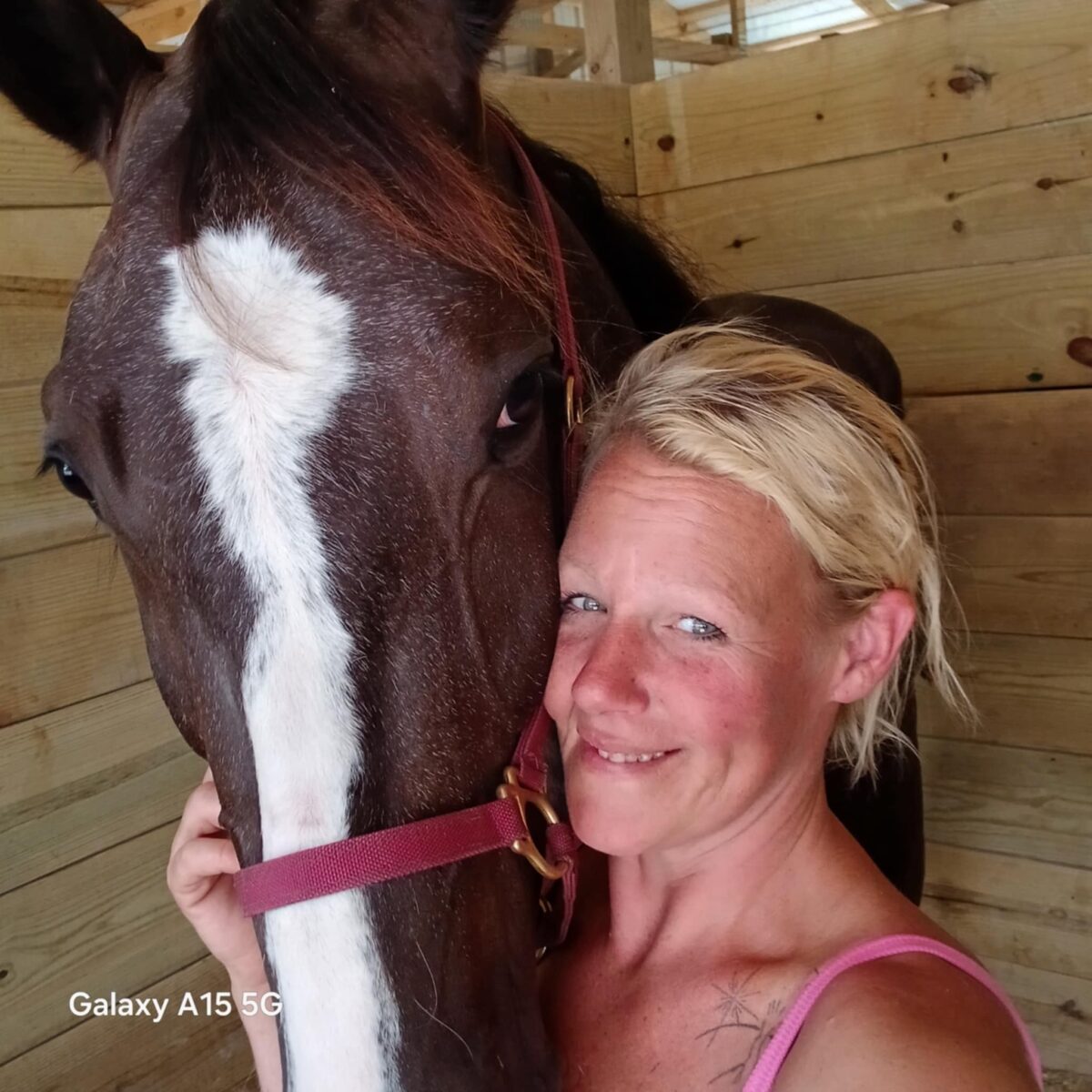Working for Burke is just as good the second time around for caretaker Inga-Lill Karlsson
by Victoria Howard
Perhaps Inga-Lill Karlsson’s path and purpose in life started when her father, Bo, came to the United States to pursue his passion in harness racing.
Bo (Balen) Karlsson was a trainer, driver, blacksmith, and also an equine dentist. He and his wife Diane (Eakin) were both involved in the Grand Circuit; training horses on a farm in Sweden that conducted pony races on the weekends.
While other 7-year-olds sat on the back of a bicycle, Inga-Lill sat behind her first racehorse. Besides being involved in harness racing, the young girl attended riding school for English dressage and jumping horses.
“My parents taught me a lot… especially my dad,” Inga-Lill said. “There isn’t a day that goes by that I don’t think of him. When I turned 19 my dad passed away and I came to the States. I set out to do what dad wanted me to do and got my trainer/driver license.
“My father told me to work for as many trainers as I could for not only does it look good on a resume, but you watch, listen, and retain the information; and to always ask questions for that’s the best way to learn. He told me when I was ready to train on my own, I could use all the valuable things the other trainers taught me. Every trainer has their ‘own way’ and as far as I’m concerned if you take something from each of them, you’re bound to come out on top.”
Inga-Lill was literally ‘born into the business,’ as her mother was working for the great Stanley Dancer, caring for a horse named Snack Bar in Kentucky when she went into labor with Inga-Lill. The hospital in Lexington was full at the time, so her daughter was born in Versailles.
“My childhood was pretty much being around horses, but after attending hotel/restaurant school to be a chef, I decided I wanted to be a vet,” she said. “I studied all my dad’s books about horse anatomy and practiced [when I was in the ninth grade] at one of the largest vet clinics in Sweden. My biggest problem was that I can watch, learn and listen, but I get restless easily, so studying was not my strong point.
“Once I figured out that I could earn a living doing what I loved the most — working with horses — I quit school. I’ve had my trainer/driver license for 16 years now and never looked back.”
Today, many of harness racing’s top trainers and drivers have come to the States from across the pond in Europe to pursue their dream with each one making a huge impact; such as the Takters, the Svanstedts, Nordin, Johansson, Jonas Czernyson, as well as those from Down Under, Noel Dailey, Nifty Norman, Chris Rider, the McCarthy brothers and Dexter Dunn, among many others.
According to Karlsson, racing is different in the Nordic countries than it is in the States.
“Wow, it’s a LOT different,” Karlsson said. “In Sweden, we only race trotters, but there are two different breeds: warm and cold-blooded trotters.
“Over there we have three different distances of races: 1640m (one mile), 2140m (one and three-quarter miles) and 3140m (almost two miles). We also have two different start methods — gate start and in circulatory system — and the number of horses competing in a race could go as high as 15.
“I was there when approximately 100,000 people stood up to do ‘the wave’ at Solvalla when the horse Victory Tilly won the Elitlopp.
“In Sweden you can bet on the races in gas stations and grocery stores. It’s really neat because you can have the machine pick your tickets, kind of like Powerball.
“We have 33 racetracks there — I believe there are 35 here in the States, I think, but then every year there are more being closed down — and our country is 10 times smaller. Harness racing is SO big over there! It’s as big as football is here.”
The name Burke is one of the most prominent names in the sport as they have been listed as No. 1 in the training ranks, re-writing the definition of standardbred trainers by shattering records for trainers in wins and money. Ever since Ron Burke took over the lead role in the Burke Stable from his father Mickey in 2009, he has led all trainers in North America. Sadly, patriarch Mickey, Sr. passed away this year, but his two sons, Ronny and Mickey are carrying on his legacy. Karlsson has worked for the Burkes not once, but twice.
“In 2011, I got a job with the Burkes, while also training my own horse,” she said. “I was in Indiana at the time and Jamie Rucker was training some of Burke’s horses. I’m Bonanzera and Rev Me Up were two horses I cared for.
“I only worked for the Burkes for one season and when it was time to ship out, I stayed in Indiana for at the time I was a single mother raising three children.
“In 2019 I went to Florida and got a job working for Ken Weimer who trains and breaks all of Burke’s babies at their training center in Astor, FL.
“The Burkes and Kenny literally saved my life two times, and I am beyond grateful. Besides Ron and Kenny, Don and Rosie Eash have also been a second family to me.”
Of all the horses she’s cared for over the years, Karlsson has a few favorites.
“There are many, but the two that have remained in my heart are Celebrity Bambino and Ervin Hanover,” she said. “My all-time favorite would be Palmetto Hanover who is now in New Jersey.”
When it comes to caretakers and outriders being viewed as the backbone of our sport and deserving the respect and praise that drivers and trainers get, Karlsson agrees.
“Not enough people are humble and grateful today,” she said. “A lot of them forget that a groom puts his/her entire life into caring for the horse. It’s not an easy job and you have to love it. Your horse — although you may not own it — becomes YOUR horse and you treat it as such. You don’t get the money the horse earns but you don’t have to pay for the bills. Nonetheless, your horse means as much to you as if you were the owner.
“And all the females who are in the business deserve the glory as much as the men. Annette Lorentzon, Nancy Takter, Jamie Rucker and Brooke Nickells, and all the others who put their time, blood, sweat and tears into it are all ‘superstars.’”


















